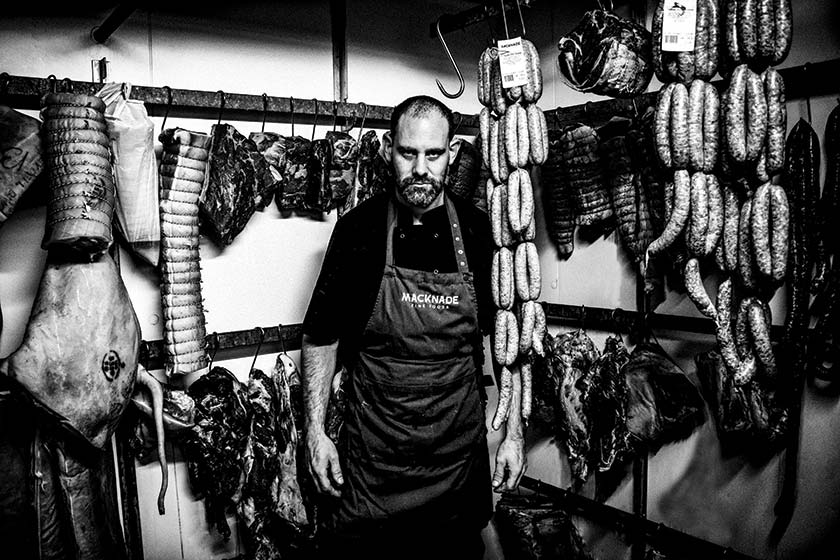Block Rockin’ Meats
From grinds to rinds - extreme sport’s loss, is the Macknade Butchery’s gain, writes Tom Ingoldby
@yellowdoor.photos
The first thing you notice about Simon Maynard is his energy. Before we can even hit record on the Dictaphone, he is talking about his love of cooking, of food or teaching customers about where their meat comes from.
“Ask a child these days where sausages come from, and most of them wouldn’t be able to tell you they come from a pig. You go into a supermarket to get your meat and it's all in a vacpac bag. No information. Nothing about the provenance. Nothing about the work that goes into it. One of my big ambitions for Macknade and the butchers is to educate. Bring that younger demographic in. Not just where the meat comes from but how to cook it, how to prepare it. What cuts are what.”
@yellowdoor.photos
You feel that the large coffee in front of him is not going to be needed.
However, as he goes for a sip of his drink, ‘cene takes its chance to get Simon, who has just taken full control of the butchers at Faversham food hall Macknade Fine Foods, to start from the beginning (and hit record).
What follows takes us from competitive skiing to Michelin starred legendary chefs to the best way to cook a steak; all at breakneck speed; all full of passion. Simon could talk food and especially meat until the cows come home...literally.
While, now he may know his shoulders from his shanks and bellies from his blades, butchery and food wasn’t his first calling.
If things had gone differently, he could have been an Olympian, talking slaloms rather than slices.
“When I was 16, I became a member of the England Freestyle Ski team. My background is extreme sports; BMXing and downhill mountain biking, that sort of thing. The dream was to be at the Olympics in ‘98. But I got an injury in the lead up and I sort of fell out of love with the sport after that.”
“If things had gone differently, Simon could have been an Olympian, talking slaloms rather than slices”
So, Simon ended up going off-piste. After a brief stint as duty manager at the Chatham Ski Centre, a managerial role at Beefeater beckoned, which, happily, enforced a mandatory six months in the kitchen. And so, the love affair with food began.
“I knew nothing about food!” Simon laughs. “Suddenly I was cooking up to 400 steaks a night! It wasn’t exactly high dining, and my mate, who had got a gig at the Swan in West Malling as a chef, used to take the piss out of me working at Beefeater. It was all ‘come down and see what real cooking is about.’ So I did!”
For the next nine months at Beefeater, Simon would spend his time off working at The Swan For free. It was there that he learnt what it really meant to be a chef. The kitchen was making everything from scratch; the bread, the crackers, the sauces.
It was a real education for the former skier and when a job for a commi-chef came up, he jumped at the opportunity, eventually rising to the position of sous-chef under maestro and mate, Scott Goss.
@yellowdoor.photos
“We smashed it. We got Rosettes under our name. It was awesome.”
London soon called, and after a brief stint at a big caterer, delivering corporate and government events, there were further kitchen positions at venues such as the famous OXO Tower and at Michel Roux’s fine dining restaurant Roux at Parliament Square.
Between Roux, renowned head chef Dan Cox and Simon, they designed the kitchen and launched the famous restaurant. But, as is often the case in the hospitality world, hours were long, and the commute to London was a killer.
“If I missed the last train back to Chatham, it was a sleeping bag on another chef’s sofa. It was getting too much.”
Fast forward a couple of years, and the chef found himself working alongside Goss again, this time at The Twenty-Six (which they launched together) in Royal Tunbridge Wells. But while Goss went onto star in the BBC’s Great British Menu, Simon raised a family and began to look for a change.
So, when did the butchery come in?
“Everywhere I had worked I had been interested in the meat side of things,” he explains. “We had always been ‘sustainable’. We had brought in everything whole. I was offered a job as a butcher at Chart Farm in Sevenoaks and it was a no brainer. I had three young children, the hours were better and I was never going to work an evening again.”
His background in the cooking world meant that he knew his rib-eyes from his fillets, but he wanted to learn more, so took a job at Macknade, a rustic farm foods store that only dealt with proper, whole cuts.
“I worked alongside some fantastic butchers at Macknade; always learning. I began to fully understand whole beef butchery and get a full picture about how the trade worked.”



